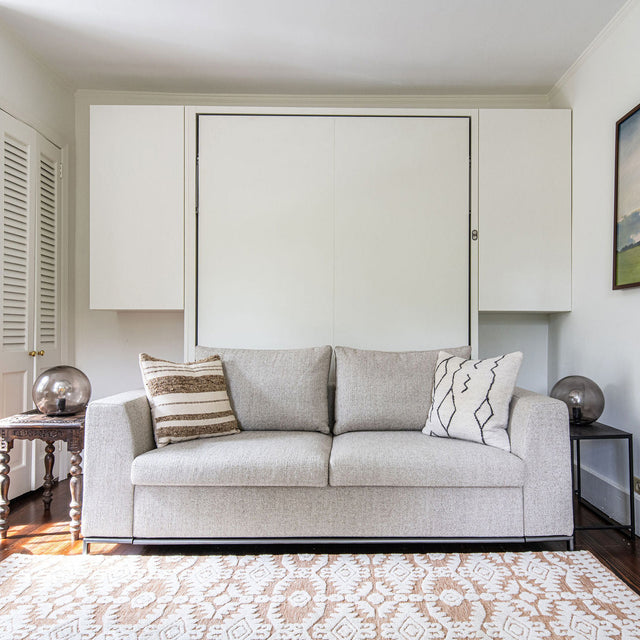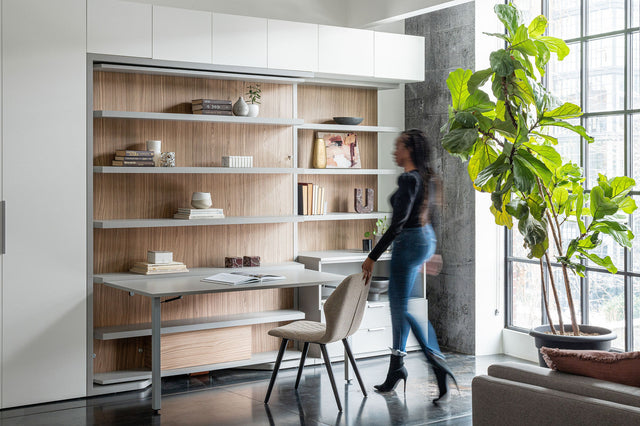Home Redecoration and Mental Health – Resource Furniture
Interior design influences the way a room looks. For instance, light colors and a minimalist style can make a room seem cheerful and spacious. On the other hand, darker colors and oversized furniture might make your space appear cramped. But interior design can affect more than the room's appearance — it can also impact your mental wellness.
There are many benefits to caring for your space, implementing new mental health décor and redecorating your room. We've put together this guide to discuss how interior design affects health. By understanding how your home affects your mental health, you can rearrange and refresh your space to improve your mental health.

Why Caring for Your Space Is a Form of Self-Care
Your personal space is a sanctuary for you to relax however you need to. It separates you from the outside world and is supposed to bring peace. Caring for your space means protecting your mental health by giving you what you need to recharge and refresh.
- Creating a reading nook: Set up a cozy nook somewhere in your home where you can sit and read.
- Decluttering: An organized space is tidier, increasing happiness.
- Redecorating: A space seems new when you change the décor or add furniture.
- Rearranging furniture: The way you arrange your furniture transforms your space.
The Benefits of Fresh Décor and Furniture on Mental Health
Consider the positive effects of interior design for human psychological health.
- Reduced anxiety: Redecorating and rearranging keeps you busy and distracted from what is causing you concern. You can see your progress, so it's hard to feel like you wasted your time. Once you have finished, you've created a relaxing and refreshing space, promoting those feelings within yourself.
- Redirected thoughts: Redecorating requires focus and decision-making. Shifting your thoughts on command can help you turn your mind away from worries and negativities.
- Improved sleep: Decorating your home can make you feel happy, safe, and secure, which improves your sleep. Some pieces, such as candles and blackout curtains, can also improve your sleep.
- Improved air quality: Moving the furniture presents an opportunity to deeply clean your home and improve the air quality. You can remove dust and dirt from the places you don't typically clean. A clean house will energize you and make you feel healthier.
- Clarity: A disorganized room can make your mind feel jumbled and messy. Part of redecorating is organizing everything. Placing items where they belong brings you peace and clarity.
- Increased interest and motivation: By decorating your home, you have a project that fixates your interest and motivates you. Additionally, your interior design affects your productivity.
- Love: Surrounding yourself with photographs of memories with your family, friends, and pets creates a positive atmosphere.
- Social confidence: Once you decorate your home, it feels more inviting, so your confidence increases, and you are more likely to share your space with friends and family.
How Décor Can Positively and Negatively Affect Your Mental State
Décor always affects your mental state. The effect depends on how you use various interior design elements. Check out this list of interior design elements and how they can negatively and positively affect you.
Natural Light
Being in natural light increases happiness, improves your mood, and energizes you. Not incorporating natural light into your interior design can decrease your satisfaction, enhance anxiety and cause poor sleep quality. With this in mind, you should decorate your home in a way that lets in as much natural light as possible. You can opt for breezy curtains and position your furniture so it doesn't block the window.
Color
Many researchers study color psychology, which is the way color affects mood. Shade, saturation, and brightness work together to trigger psychological responses. Here are the different terms used to classify colors.
- Saturation: This term refers to the pureness of the color. For example, less saturated colors have more black or gray in them.
- Brightness: The amount of white in a color is its brightness. It affects how light the color seems.
- Warm: Reds, oranges, and yellows make rooms feel warmer.
- Cool: These colors make rooms feel cooler and include blues, greens, and purples.
When you redecorate your home, you can pay attention to color. Here are some popular color choices and their psychological effects.
- White: Light bounces around in white rooms, creating a calm, positive atmosphere. However, an all-white room feels sterile, so you must mix white with other colors.
- Blue: Dark blue or too much blue can evoke feelings of detachment and sadness.
- Red: The color red can stir feelings of love and passion or hate and anger. You must consider how red makes you feel before using it in your décor.
- Gray: While gray is a wonderful neutral color, you should layer it with other colors. Too much gray can make you feel lonely and isolated.
Function
A room's layout affects its functionality. It can be frustrating when a room doesn't flow as it should — for instance, if it is a tight squeeze between the sofa and the coffee table to find a seat, or if a cabinet is too high for you to reach.
To incorporate function into your interior design, you must consider how you typically move around and use the room. Arranging your furniture to reflect the room's function makes your space more open.
Clutter
A cluttered room is stressful. You see clothes or shoes on the floor, books scattered about, and random items covering every surface. Knowing everything is not where it should be can cause anxiety, making the mess seem increasingly impossible as it piles up. Tackling clutter is freeing as if you are throwing away your stress.
Investing in new furniture can help you declutter and reorganize. For instance, you can incorporate hidden storage solutions, like built-in wall shelves or cabinets. These take up less space than free-standing shelves and offer more storage space.
Redecorate Your Home With Resource Furniture
Interior design and mental health go hand in hand. Redecorating your home can transform its atmosphere, so it is inviting, warm and spacious. Rearranging your furniture and refreshing the décor can help you get the most benefits from redecorating. When adding new furniture, you want it to be high-quality, stylish, and functional.
Look no further than Resource Furniture for your furnishing needs. Our multifunctional furniture adds flexibility to your home by allowing you to have multipurpose rooms. Browse our innovative storage solutions to help you tidy your home while adding something fresh.
Recent Posts

13 Storage Ideas for Small Spaces: Shelves, Walls, and Containers

5 Garage Conversion Ideas to Inspire Your Next Home Upgrade

6 Ways to Create a Hotel-Like Guest Room Experience

Aging in Place That Actually Feels Like Home

Does Converting a Garage to a Living Space Add Value? What to Know Before You Start







